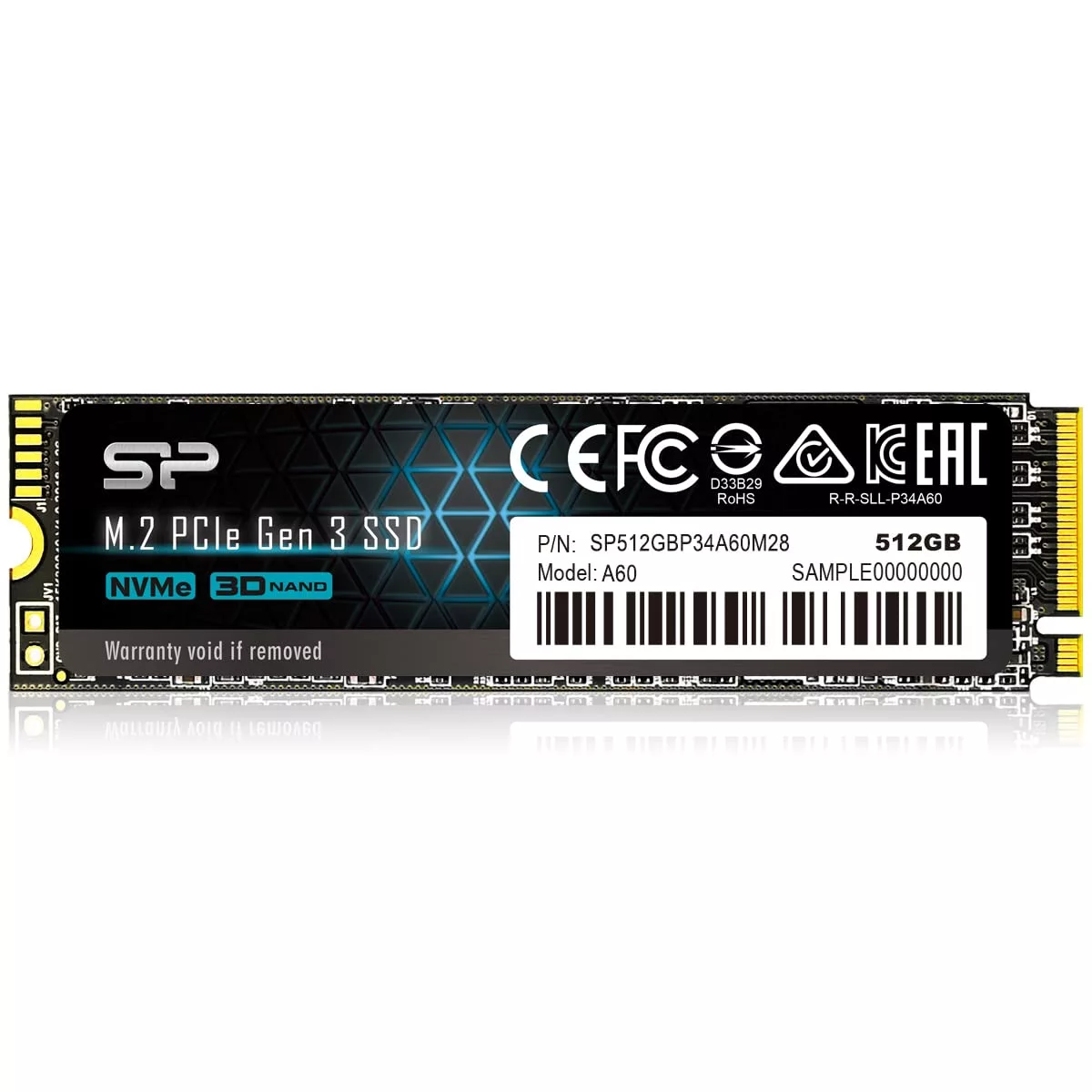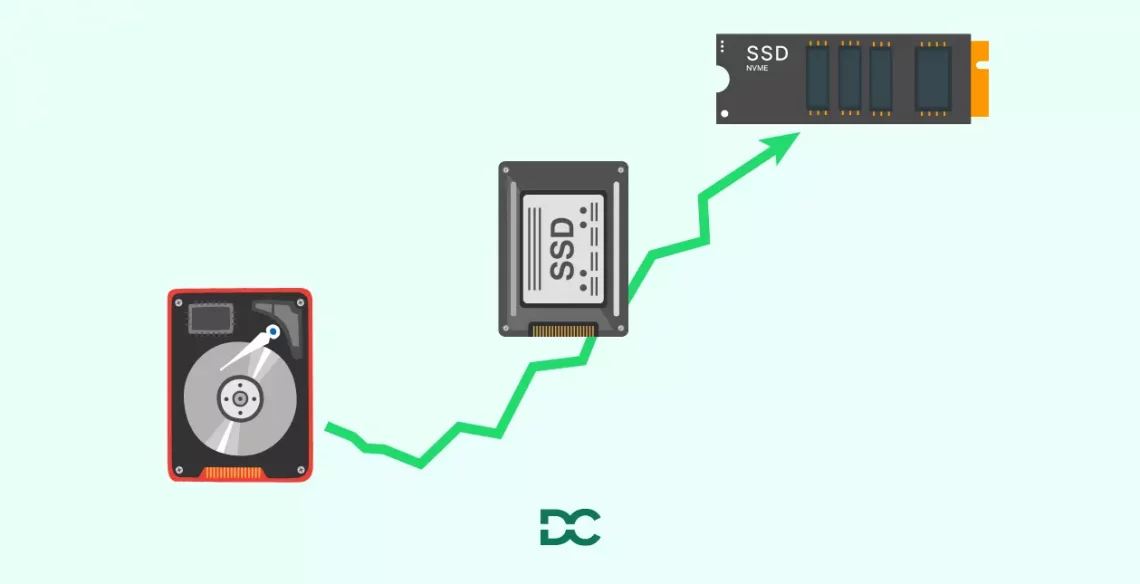Solid State Drives (commonly referred to as SSDs) have swiftly emerged as a superior alternative to HDDs, outpacing and replacing them. SSD stands for Solid State Drive, a NAND storage device that utilizes flash memory for data storage. Similar to HDDs, SSDs can also serve as a centralized storage system. However, SSDs boast significantly faster read and write speeds due to the absence of moving parts.
By enhancing disk speed, SSDs dramatically improve overall system performance. Nowadays, SSDs have become the go-to choice for most users, providing exceptional performance and saving valuable time and effort. The increasing presence of SSDs in budget-friendly laptops is a testament to their growing popularity and impact.
In contrast, HDDs suffer from inherent latency and access time caused by mechanical delays in spinning platters and read/write head movements. Since SSDs lack moving components, the latency and time required to access and store data are significantly reduced.
While there is technical complexity involved, a straightforward analogy is comparing a pen drive to a CD. Pen drives have faster data transfer speeds, whereas CDs take longer to perform the same task.
- Faster boot up times and overall system performance
- Better Read & Write Speed
- Increased durability as they contain no moving parts
- Low energy consumption, leading to lower electricity bills
- Greater resistance to external trauma and shock
- More reliable data protection, as their lack of moving parts minimizes the chances of hardware failure
Types of SSDs
Internal SSD vs External SSD
There is not any rocket science in understanding it because simply, both serve the same purpose. Internal SSD is directly installed inside the computer connecting it with the motherboard. Whereas an external SSD is connected to the CPU via a USB port or Thunderbolt connection. You can replace your PC’s HDD with SSD and increase the speed of your system.
SSDs are available in different shapes and sizes, have different speeds, and obviously different Prices. On the basis of form factor, SSDs can be classified into 3 types:
M.2 SSD

The M.2 SSD, also referred to as the Next Generation Form Factor, has truly transformed storage technology. This Solid State Drive boasts a compact size while delivering lightning-fast speed, making it a sought-after option for both consumer electronics and enterprise systems alike.
M.2 SSD is great for someone who is looking to upgrade a PC or laptop for high-end tasks like gaming, video editing, graphic designing, etc. These SSDs do not need to be connected through USB as they can be directly connected to the motherboard with a dedicated M2 slot.
M.2 SSDs are mounted internally inside a PC. It is small as compared to other SSDs and it is specifically made to deliver high performance in small-sized laptops and powerful PCs. An M.2 SSD can be used with both SATA and PCIe protocols. SATA is a standard for connecting and transferring data from HDDs to computer systems. PCIe, which is a serial expansion bus standard, is used to connect a computer to one or more peripheral devices.
Pros
Cons
SATA SSD

Built upon the foundation of NAND flash memory, the SATA SSD combines the speed and efficiency of solid-state technology with the familiar Serial ATA interface, making it a widely used storage solution in both consumer and professional computing environments. The SATA interface is a standardized connection used to link storage devices to a computer’s motherboard. While not as fast as newer interfaces like NVMe (Non-Volatile Memory Express), SATA still offers a substantial performance improvement over traditional HDDs. SATA SSDs typically use the 2.5-inch form factor, resembling the size and shape of standard laptop HDDs.
ATA SSDs can significantly reduce boot times, application loading times, and data transfer delays. For tasks such as video editing, gaming, software development, and even basic office work, the improved speed and responsiveness of a SATA SSD can make a noticeable difference in overall productivity.
With its combination of NAND flash memory technology and the familiar SATA interface, a SATA SSD remains a popular choice for upgrading existing systems or building new ones, striking a balance between affordability and performance.
Pros
Cons
NVMe SSD

NVMe stands for “Non-Volatile Memory Express. It uses the NVMe protocol to communicate with a computer’s hardware and software and it is a modern storage technology designed to take full advantage of the high-speed capabilities of NAND flash memory.
NVMe SSDs offer significantly faster data transfer speeds compared to older storage technologies like SATA SSDs or HDDs. They are capable of delivering incredibly low latency and high input/output operations per second (IOPS), which results in faster boot times, quicker application loading, and improved overall system responsiveness.
NVMe SSDs typically use a PCIe (Peripheral Component Interconnect Express) interface to connect to the motherboard, which allows them to take full advantage of the high bandwidth capabilities of modern PCIe slots.
- NVMe SSDs have very low latency meaning they can quickly access data and respond to read and write requests. This is particularly important for tasks that require quick data access, such as gaming and video editing.
- It offers high Input/Output Operations Per Second (IOPS), which means it can handle a large number of simultaneous read and write operations. This is beneficial for tasks involving multitasking.
- NVMe SSDs are compatible with modern systems that have PCIe slots. Most motherboards and laptops manufactured in recent years include M.2 or PCIe slots that can accommodate NVMe SSDs.
- Expensive than SATA SSDs.
- Can Generate More Heat
- Some older systems might not have the necessary M.2 or PCIe slots to accommodate these drives.
FAQs
How do I choose the right SSD for my needs?
Consider factors such as storage capacity, performance requirements (SATA vs. NVMe), and your budget. If you’re a casual user, a mid-range SATA SSD might be sufficient. For demanding tasks like gaming or content creation, consider investing in a higher-end NVMe SSD with faster speeds.
What is the difference between SATA and NVMe SSDs?
SATA SSDs use the SATA (Serial ATA) interface, which was originally designed for HDDs. NVMe SSDs use the NVMe (Non-Volatile Memory Express) protocol and connect to PCIe slots, allowing for much faster data transfer speeds. NVMe SSDs are generally faster and more suitable for high-performance tasks like gaming, video editing, and professional applications.
Can I use an SSD with an older computer?
It depends on the interface and slots available in your older computer. If your computer has a compatible interface (such as SATA) and a suitable slot, you can use an SSD. However, if your computer is quite old and lacks the necessary interfaces, compatibility could be an issue.
How do I migrate my data from an HDD to an SSD?
You can migrate your data from an HDD to an SSD using cloning software. This software creates a copy of your HDD’s data and transfers it to the SSD. Some SSD manufacturers provide their own migration tools, and there are also third-party options available.
Are all M.2 SSDs NVMe?
No, M.2 SSDs come in both SATA and NVMe variants. SATA-based M.2 SSDs function similarly to 2.5-inch SATA SSDs but use the M.2 form factor. NVMe-based M.2 SSDs offer faster speeds due to the NVMe protocol and PCIe interface.
What’s the difference between M.2 SATA and M.2 NVMe SSDs?
M.2 SATA SSDs use the SATA interface and offer speeds similar to traditional 2.5-inch SATA SSDs. M.2 NVMe SSDs, on the other hand, use the NVMe protocol and PCIe interface, providing significantly faster data transfer speeds. NVMe SSDs are generally better suited for high-performance tasks.
Are there any drawbacks to using M.2 SSDs?
One potential drawback is that some M.2 SSDs can generate more heat due to their compact form factor and high speeds. It’s important to ensure proper airflow and cooling in your system, especially if you’re using multiple M.2 SSDs. Additionally, if your system lacks M.2 slots or compatible interfaces, you might need to use an adapter or choose a different type of SSD.
How does an M.2 SSD differ from other SSDs?
M.2 SSDs differ primarily in their physical design and interface. They connect directly to the motherboard through an M.2 slot, eliminating the need for cables. This makes them more compact and easier to install, especially in small-form-factor systems.
Over to you
So, here we are, at the end of the article. In this article, I have tried to solve the doubts regarding SSDs and their types. Every SSD whether it’s SATA, NVMe, or M2 are lot faster than a traditional HDD. All are made to deliver fast performance but they differ in their sizes and focus areas. M2 is made for faster performance and is suitable for devices with compact sizes whereas, SATA provides you with storage also.
With this, I would end the article. Hope and like the article, and if YES then take a second and comment down below.







